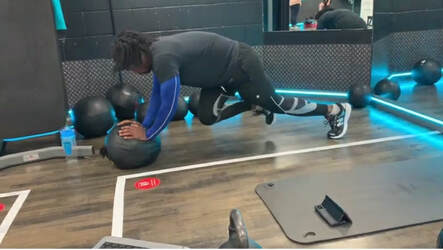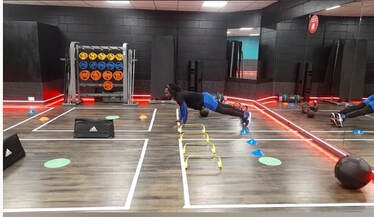 So, you've never lifted weights in your life and many people haven't, then why should you start now? The answer is simple: Muscle tissue, bone density, and strength all dwindle over the years. So, too, does muscle power. These changes open the door to accidents and injuries that can compromise your ability to lead an independent, active life. Strength training is the most effective way to slow and possibly reverse much of this decline. Strong muscles help the body in many ways. Strong muscles pluck oxygen and nutrients from the blood much more efficiently than weak ones. That means any activity requires less cardiac work and puts less strain on your heart. Strong muscles help the body stay sensitive to insulin by making it easier for sugar to move into cells, In these ways, strong muscles can help keep blood sugar levels in check, which in turn helps prevent or better control type 2 diabetes. Strong muscles also enhance weight control. On the other hand, weak muscles hasten the loss of independence as everyday activities — such as walking, cleaning, shopping, and even dressing — become more difficult. They also make it harder to balance your body properly when moving or even standing still, or to catch yourself if you trip. The loss of power compounds this. Perhaps it's not so surprising that, by the age 35 and up, one in three people reports falls. Because bones also weaken over time, one out of every 20 of these falls ends in fracture, usually of the hip, wrist, or leg. The good news is that the risk of these problems can be reduced by an exercise and fitness routine that includes strength training. Beginner's simple strength boosting exercises Mobility Warm Perform 4 Sets of 10 to 12 Reps, 30-45 seconds rest ( Each Exercise)
0 Comments
 Balance is the ability to maintain a controlled body position during task performance, whether it is sitting at a table, walking the balance beam, or stepping up onto a kerb. To function effectively across environments and tasks, we need the ability to maintain controlled positions during both static (still) and dynamic (moving) activities. Static balance is the ability to hold a stationary position with control (e.g. “Freeze” or “statue” games). Dynamic balance is the ability to remain balanced while engaged in movement (e.g. running or bike riding). Working on your balance probably isn’t an integral part of your everyday life or workout, but here is my theory behind why it should be. The benefits for improved balance range from a reduced risk of injury to improving intelligence and even potentially increasing one’s life span. With that in mind, here are my three main reasons to work on improving your balance, as well as some ideas on how to get started. Performance Enhancement Improved balance and muscle group coordination will naturally increase your body’s ability to control itself during challenging tasks. For athletes, this means improved agility, quicker reaction times, and improved overall performance. For non-athletes, it could mean being able to forgo use of a cane for short periods of time or being able to safely walk on grass in the park instead of having to stick to sidewalks. Balance Goes Beyond your Legs When you work on your balance, you’re concurrently firing a multitude of muscles from your head to your toes. Challenging your muscle groups to work together in ways that they haven’t had to before can lead to improved control of muscle groups that may have been dormant from years of sitting and leaning. Learning (or re-learning) how to use your muscles synergistically can improve your posture and strength, which can have several health benefits including a reduced chance of getting arthritis, back pain, or other health issues. Balance for Injury Prevention Improving your balance has shown a lot of promise in being able to prevent injuries for a wide range of people. For athletes, balance work is associated with a dramatically lower risk of injury. Just one sprained ankle can alter your season and will predispose you to future ankle sprains for life, but regular balance work can decrease your risk of a sprain by nearly 40%. For the elderly, improved balance could prevent a fall, which is the cause of over 90% of all hip fractures–one of people’s most life-altering (and shortening) injuries. I think it’s obvious that the potential benefits of working on your balance will greatly outweigh the small-time investment on your part.  Being a Fitness Coach I can safely say one of the most overlooked aspects of exercise is stretching after a strenuous workout. Stretching tired and sore muscles after a workout is essential as it enhances flexibility and reduces muscle tension after a workout. Stretching should be a part of any well-balanced workout routine or programs, given the same importance as strength and cardiovascular training. Stretching after working out should not only highly recommended practice but must be practise without failing. The benefits of stretching before a workout are often discussed, emphasizing its role in injury prevention. When you stretch after a workout, you benefit from both physiological and psychological effects. Your muscles should be warm before you begin your stretching. Do a warmup before a workout that simulates the movements, you’ll be doing to warm up and prepare your body. Stretch after the workout when your muscles are already warm. Improved Blood circulation When you indulge in an intense workout, the body pumps blood faster to the heart making it beat at a rapid rate. Stretching allows the body to cool down and helps the heartbeat to return to normalcy. The release of lactic acid during an intense workout is broken with stretching. This allows muscle recovery and repair. The blood circulation to the muscles is once again resumed with stretching. This also allows the heart rate to come back to its original resting rate. Eliminates Lactic Acid The moment you work out muscles, the body produces lactic acid which makes the muscles fatigued and sore. Hence, it is important to stretch as stretching eliminates the lactic acid that has accumulated inside the body and relaxes the muscles. Increased Flexibility One of the foremost benefits of stretching is increased and enhanced flexibility of the different muscle groups. It helps constricted and contracted muscles release back to their more comfortable state and your body will eventually become more flexible, which can help prevent injuries With consistent post -workout stretching, the body becomes more flexible. You will find it easier to bend, stand, squat and do a host of other flexibility related exercises, which would have otherwise not been possible. It has been seen that leg stretches done after a long run increases muscular power and endurance especially for runners. Pain Prevention Stretching properly after a workout will not dissipate the pain but will minimize it to a large extent. On the other hand, if your muscles remain tight after a workout, it increases your risk of muscle injury. Stretching can minimize and reduce your predisposition to injuries. Improved Range of Motion Muscles that have not been stretched tend to remain constricted which prevents you from using them to their full capacity. If you use your muscles and stretch them after a workout, you will be able to utilize the same muscles towards a greater range of motion. This will get your better results because you will have used your muscles to their maximum capacity. Increased Muscular Coordination Enhanced muscle coordination is a common benefit of stretching, especially for people participating in strength training. When you stretch tired muscles, you give them better functional mobility and allow them to synchronize properly. Gradually slows down the body When you go through an intense bout of exercise, your body can feel drained and fatigued, but stretching and breathing techniques will help you feel rested and relaxed. By gradually slowing down the body, as opposed to just stopping cold, you maximize the benefits of your workout. Mental clarity and mind-body connection Stretching isn’t just for the muscles. It also helps harmonize your mind, relax your mood, and relieve stress. Stretching also gives you a chance to tune into your body, taking notice of any sore muscles or joints that need extra attention or a break.  The best exercise I do in any of my training programs only takes a minute. Granted, it is often the longest and most gruelling 60 seconds of my life. I sweat, I shake, and I often collapse in relief when it’s over. But spending quality time in a plank pose always pays off. The plank pose is where you hold a push-up position while resting on your forearms. This simple move is the ideal exercise for strengthening crucial core muscles. As you go about your day, almost every move you make revolves around your core — from picking up items on the floor to twisting to see if the coast is clear when driving. Why is it important to have a strong core? Your core is made up of several muscle groups and covers your abdominals, back, hips, pelvis, and buttocks. A weak core can cause all kinds of problems. It can lead to poor posture, and inevitably to neck and shoulder pain. Sore knees and hips often can be traced to a weak core. But the biggest issue with core weakness is pain lower Back muscles and your core help to stabilize your body before any movement. If your core is weak, the other surrounding muscles must compensate. Over time, these muscles can suffer strain, which leads to lingering pain. More Planks and Less sit-up The standard sit-up is often the go-to core strengthened, but it has limits. “It only targets a portion of the core musculature, and the bending-forward motion can strain the neck and lower back,” By comparison, the plank pose activates all the core muscles at once and doesn’t require extra movements that can cause stress or injury. “And because it has many modifications, it can be done by almost anyone, regardless of current fitness level,” How long should you hold a plank? The world record for holding a plank is more than four hours, but thankfully, you don’t need to devote that much time. Most experts suggest anywhere from 10 up to 30 seconds is plenty. “Focus on doing multiple sets of smaller amounts of time As you progress, you can extend your plank for up to one or even two minutes, but don’t go beyond that. “Two minutes is often considered the maximum, and you don’t get much more benefit after that. How often should you do planks? You can perform a plank every day, on alternate days, or simply as part of your regular workouts. (I personal add plank in my routines every training days with different progressions and regressions.) |
AuthorsThis blog is updated by Tranquillity 360 fitness personal trainers, as well as other guest bloggers. Archives
July 2021
Categories |

 RSS Feed
RSS Feed